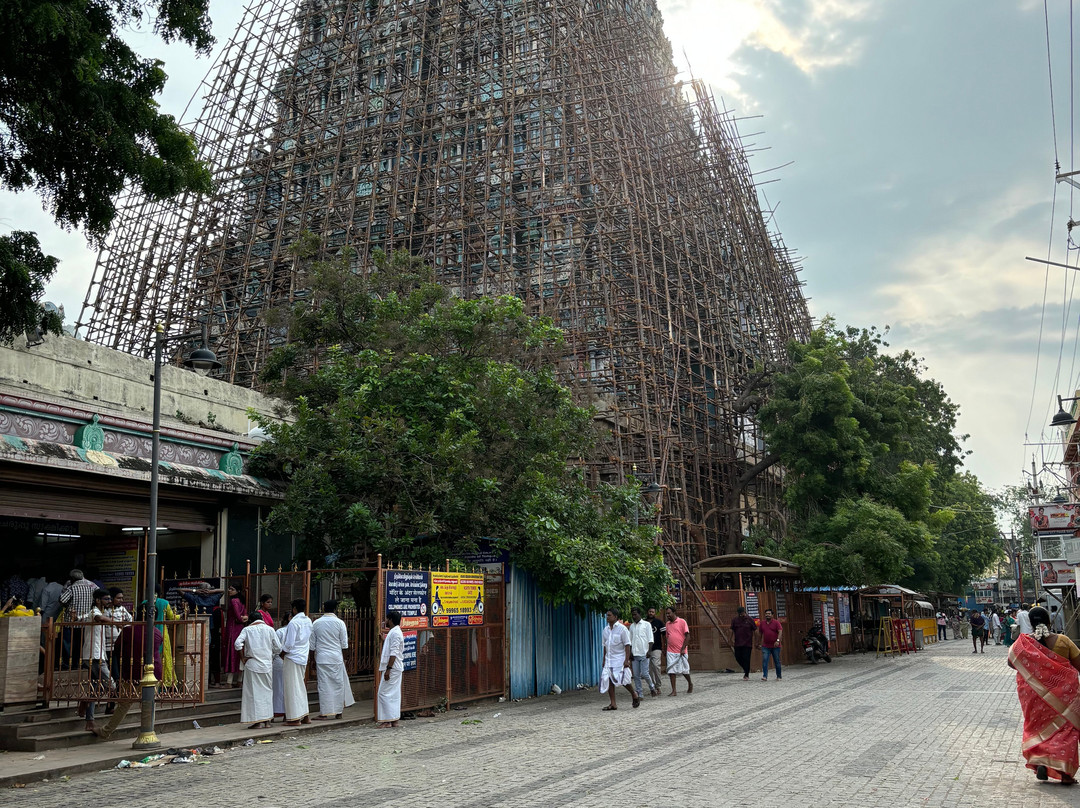的点评
A historical and cultural significance and mystical darshan
密纳克西神庙的点评
点评:The Meenakshi Amman Temple in Madurai is a masterpiece of Dravidian architecture and holds immense historic and cultural significance in India. Here’s an overview based on historical records and scholarly accounts:
Historic Significance
The temple dates back to ancient times, with references as far back as the early centuries CE in Tamil literature. However, the current structure, known for its grandeur, was primarily developed in the 12th to 17th centuries. The temple is dedicated to Goddess Meenakshi, an incarnation of Parvati, and her consort Lord Sundareswarar (Shiva). It symbolizes the Tamil people’s devotion to the divine and their architectural prowess.
Construction Timeline and Involvement
The temple’s original structure was likely built during the Pandya Dynasty in the early centuries CE, although many of its current features were added and expanded over several centuries. Here’s a brief outline:
• Pandya Dynasty: The initial structure is attributed to the Pandya rulers, who ruled from the 6th century CE onward.
• Vijayanagara Empire: The most significant additions and renovations took place during the rule of the Vijayanagara kings in the 16th century, especially under King Krishna Deva Raya.
• Nayak Dynasty: In the early 17th century, Tirumala Nayaka, a prominent Nayak king, made substantial contributions to the temple’s design, including its towering gopurams (gateway towers) and hallways.
Architects and Craftsmen
While there is no single architect credited, the temple’s construction and expansion involved numerous skilled artisans, sculptors, and architects across generations. The guilds of temple architects during the time of the Vijayanagara and Nayak dynasties were well-known for their expertise in Dravidian architecture, and the collaborative nature of this construction meant that generations of craftsmen contributed to its present form.
Architectural Features and Timeline
• The temple complex took several centuries to reach its current form, with each ruling dynasty adding layers of design.
• The temple’s grand structure, including the towering gopurams, Hall of Thousand Pillars, and various shrines, showcases the cumulative work of artisans and rulers spanning approximately 500–700 years.
• Its current form is largely due to the Nayak period (16th–17th centuries), which saw the construction of most of the present-day features.
Key Architectural Highlights
1. Gopurams (Gateway Towers): The temple has 14 gopurams, each covered in colorful, intricate carvings. These towers are famous for their height and detail, symbolizing the grandeur of Dravidian architecture.
2. Hall of Thousand Pillars: This hall is one of the temple’s most iconic sections, renowned for its 985 uniquely carved pillars.
3. Sacred Tanks and Halls: The temple includes sacred water bodies, including the Golden Lotus Tank, which adds to its spiritual and architectural allure.
The Meenakshi Temple is more than a religious site; it’s a historical testament to the dedication and skill of the Pandya, Vijayanagara, and Nayak dynasties, as well as countless unnamed artisans. Its construction, spanning centuries, reflects the evolving styles and devotion of South Indian rulers and communities, making it one of the most revered and architecturally significant temples in India and the world.
Historic Significance
The temple dates back to ancient times, with references as far back as the early centuries CE in Tamil literature. However, the current structure, known for its grandeur, was primarily developed in the 12th to 17th centuries. The temple is dedicated to Goddess Meenakshi, an incarnation of Parvati, and her consort Lord Sundareswarar (Shiva). It symbolizes the Tamil people’s devotion to the divine and their architectural prowess.
Construction Timeline and Involvement
The temple’s original structure was likely built during the Pandya Dynasty in the early centuries CE, although many of its current features were added and expanded over several centuries. Here’s a brief outline:
• Pandya Dynasty: The initial structure is attributed to the Pandya rulers, who ruled from the 6th century CE onward.
• Vijayanagara Empire: The most significant additions and renovations took place during the rule of the Vijayanagara kings in the 16th century, especially under King Krishna Deva Raya.
• Nayak Dynasty: In the early 17th century, Tirumala Nayaka, a prominent Nayak king, made substantial contributions to the temple’s design, including its towering gopurams (gateway towers) and hallways.
Architects and Craftsmen
While there is no single architect credited, the temple’s construction and expansion involved numerous skilled artisans, sculptors, and architects across generations. The guilds of temple architects during the time of the Vijayanagara and Nayak dynasties were well-known for their expertise in Dravidian architecture, and the collaborative nature of this construction meant that generations of craftsmen contributed to its present form.
Architectural Features and Timeline
• The temple complex took several centuries to reach its current form, with each ruling dynasty adding layers of design.
• The temple’s grand structure, including the towering gopurams, Hall of Thousand Pillars, and various shrines, showcases the cumulative work of artisans and rulers spanning approximately 500–700 years.
• Its current form is largely due to the Nayak period (16th–17th centuries), which saw the construction of most of the present-day features.
Key Architectural Highlights
1. Gopurams (Gateway Towers): The temple has 14 gopurams, each covered in colorful, intricate carvings. These towers are famous for their height and detail, symbolizing the grandeur of Dravidian architecture.
2. Hall of Thousand Pillars: This hall is one of the temple’s most iconic sections, renowned for its 985 uniquely carved pillars.
3. Sacred Tanks and Halls: The temple includes sacred water bodies, including the Golden Lotus Tank, which adds to its spiritual and architectural allure.
The Meenakshi Temple is more than a religious site; it’s a historical testament to the dedication and skill of the Pandya, Vijayanagara, and Nayak dynasties, as well as countless unnamed artisans. Its construction, spanning centuries, reflects the evolving styles and devotion of South Indian rulers and communities, making it one of the most revered and architecturally significant temples in India and the world.
翻译:马杜赖的米纳克希阿曼神庙是达罗毗荼建筑的杰作,在印度具有巨大的历史和文化意义。以下是基于历史记录和学术记载的概述:
历史意义
这座神庙的历史可以追溯到古代,早在公元初泰米尔文献中就有记载。然而,以宏伟著称的现有建筑主要是在 12 至 17 世纪修建的。这座神庙供奉的是帕尔瓦蒂的化身米纳克希女神和她的配偶桑达雷斯瓦拉尔勋爵(湿婆)。它象征着泰米尔人对神的虔诚和他们的建筑才能。
建设时间表和参与
这座神庙的原始结构很可能是在公元初潘迪亚王朝时期建造的,尽管它的许多现有特征都是在几个世纪中增加和扩建的。以下是简要概述:
• 潘迪亚王朝:最初的建筑归功于潘迪亚统治者,他们从公元 6 世纪开始统治。
• 毗奢耶那伽罗帝国:最重要的增建和翻新发生在 16 世纪毗奢耶那伽罗国王统治期间,尤其是在克里希那·德瓦·拉亚国王统治期间。
• 纳亚克王朝:17 世纪初,著名的纳亚克国王蒂鲁马拉·纳亚卡为寺庙的设计做出了重大贡献,包括其高耸的门楼和走廊。
建筑师和工匠
虽然没有一位建筑师被提及,但寺庙的建造和扩建涉及了一代又一代的众多熟练工匠、雕塑家和建筑师。毗奢耶那伽罗王朝和纳亚克王朝时期的寺庙建筑师行会以其在达罗毗荼建筑方面的专业知识而闻名,这种建筑的合作性质意味着一代又一代的工匠为其现在的形式做出了贡献。
建筑特色和时间轴
• 寺庙建筑群历经几个世纪才达到现在的形态,每个统治王朝都增加了设计层次。
• 寺庙的宏伟结构,包括高耸的塔楼、千柱殿和各种神殿,展示了工匠和统治者在大约 500-700 年内的累积成果。
• 其目前的形式很大程度上归功于纳亚克时期(16-17 世纪),该时期建造了大多数现在的建筑。
主要建筑亮点
1. 塔楼(门塔):寺庙有 14 个塔楼,每个塔楼上都覆盖着色彩缤纷、错综复杂的雕刻。这些塔以其高度和细节而闻名,象征着德拉威建筑的宏伟。
2. 千柱大厅:这座大厅是寺庙最具标志性的部分之一,以其 985 根独特的雕刻柱子而闻名。
3. 圣水池和大厅:寺庙包括圣水体,包括金莲花水池,这增加了它的精神和建筑魅力。
米纳克什神庙不仅仅是一个宗教场所;它是潘迪亚、维查耶纳加拉和纳亚克王朝以及无数无名工匠的奉献精神和技艺的历史见证。它的建造跨越几个世纪,反映了南印度统治者和社区不断变化的风格和奉献精神,使其成为印度和世界上最受尊敬和建筑意义重大的寺庙之一。
历史意义
这座神庙的历史可以追溯到古代,早在公元初泰米尔文献中就有记载。然而,以宏伟著称的现有建筑主要是在 12 至 17 世纪修建的。这座神庙供奉的是帕尔瓦蒂的化身米纳克希女神和她的配偶桑达雷斯瓦拉尔勋爵(湿婆)。它象征着泰米尔人对神的虔诚和他们的建筑才能。
建设时间表和参与
这座神庙的原始结构很可能是在公元初潘迪亚王朝时期建造的,尽管它的许多现有特征都是在几个世纪中增加和扩建的。以下是简要概述:
• 潘迪亚王朝:最初的建筑归功于潘迪亚统治者,他们从公元 6 世纪开始统治。
• 毗奢耶那伽罗帝国:最重要的增建和翻新发生在 16 世纪毗奢耶那伽罗国王统治期间,尤其是在克里希那·德瓦·拉亚国王统治期间。
• 纳亚克王朝:17 世纪初,著名的纳亚克国王蒂鲁马拉·纳亚卡为寺庙的设计做出了重大贡献,包括其高耸的门楼和走廊。
建筑师和工匠
虽然没有一位建筑师被提及,但寺庙的建造和扩建涉及了一代又一代的众多熟练工匠、雕塑家和建筑师。毗奢耶那伽罗王朝和纳亚克王朝时期的寺庙建筑师行会以其在达罗毗荼建筑方面的专业知识而闻名,这种建筑的合作性质意味着一代又一代的工匠为其现在的形式做出了贡献。
建筑特色和时间轴
• 寺庙建筑群历经几个世纪才达到现在的形态,每个统治王朝都增加了设计层次。
• 寺庙的宏伟结构,包括高耸的塔楼、千柱殿和各种神殿,展示了工匠和统治者在大约 500-700 年内的累积成果。
• 其目前的形式很大程度上归功于纳亚克时期(16-17 世纪),该时期建造了大多数现在的建筑。
主要建筑亮点
1. 塔楼(门塔):寺庙有 14 个塔楼,每个塔楼上都覆盖着色彩缤纷、错综复杂的雕刻。这些塔以其高度和细节而闻名,象征着德拉威建筑的宏伟。
2. 千柱大厅:这座大厅是寺庙最具标志性的部分之一,以其 985 根独特的雕刻柱子而闻名。
3. 圣水池和大厅:寺庙包括圣水体,包括金莲花水池,这增加了它的精神和建筑魅力。
米纳克什神庙不仅仅是一个宗教场所;它是潘迪亚、维查耶纳加拉和纳亚克王朝以及无数无名工匠的奉献精神和技艺的历史见证。它的建造跨越几个世纪,反映了南印度统治者和社区不断变化的风格和奉献精神,使其成为印度和世界上最受尊敬和建筑意义重大的寺庙之一。


此点评仅代表旅行者个人的主观意见,并不代表TripAdvisor以及其合作方的意见。
关于我们
|
新闻动态
|
商务合作
|
会员中心
|
业主中心
|
业主通
|
常见问题
|
意见反馈
|
联系我们
|
营业执照
© 2025 Tripadvisor 版权所有。
使用条款 |隐私政策 |网站工作原理
部分照片由 VFM Leonardo 提供。
* Tripadvisor不是旅行社,也不是旅游预订服务代理商。我们提供免费、客观、公正的旅游资讯服务。 (显示更多)
TripAdvisor LLC 既不是预订代理商,也不是旅游运营商,不会向网站用户收取任何服务费。 按照规定,在 Tripadvisor 发布机票价格、游览和旅行套餐的合作伙伴(航空公司、旅行提供商及预订代理商),其标价须包含所有费用和附加费用。 例如, 机场出入境税费、消费税与其他服务费、手续费、杂费及附加费用。 当您向我们的某个合作伙伴进行预订时,请务必查阅他们的网站以了解当地行政部门要求的所有适用费用的具体情况。 除非另有说明,机票价格通常指的是一个人的价格(以人民币计)。
为方便起见,TripAdvisor LLC 根据从我们的预订合作伙伴获取的空房率计算每个酒店的均价。 对于游览和景点来说,所显示价格通常是每位成人的最低可用价格。 对于列出的任何旅行套餐或优惠,TripAdvisor LLC 无法保证任何特定的费率或价格。 此外,酒店均价每晚会更新,并以您的首选币种表示(使用现行汇率)。 由于这些已换算的价格是预估价格,因此,有关具体金额和币种请与预订网站进行核实。
此外,TripAdvisor LLC 无法保证我们网站上宣传的价格随时有效。 标价可能需要预订一定天数才能生效,或有不可用日期、使用条件或限制。
TripAdvisor公司对外部网站的内容一概不负责。优惠价格中不含税和其他费用。
ICP证:沪B2-20200433
沪ICP备20013175号
 沪公网安备31010502005427号
沪公网安备31010502005427号鹰程信息技术(上海)有限公司
货币/国家及地区
¥CNY
中国

